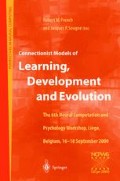Abstract
Several theories of action selection assume that the environment both suggests and constrains possible actions at each moment. We present an interactive activation model (based on an existing model of routine sequential action selection) in which actions are organised into partially ordered schemas for simple task elements, and the current state of the environment contributes to selecting actions and schemas. Previous versions of the model have not accounted for learning. We show that a simple reinforcement learning paradigm allows environment-action associations to be acquired through unguided exploration of the environment. The basic model is limited in the types of environment/action associations that it acquires. We explore ways in which greater diversity of learning (and behaviour) may be achieved, and suggest that, in order to acquire a broad range of environment/action associations, mechanisms for boredom avoidance or novelty seeking are required.
Access this chapter
Tax calculation will be finalised at checkout
Purchases are for personal use only
Preview
Unable to display preview. Download preview PDF.
References
Cooper, R., & Fox, J. (1998). COGENT: A visual design environment for cognitive modeling. Behavior Research Methods, Instruments, and Computers, 30, 553–564.
Cooper, R., & Shallice, T. (2000).Contention Scheduling and the control of routine activities. Cognitive Neuropsychology, 17, 297–338.
Cooper, R., Shallice, T., & Farringdon, J. (1995). Symbolic and continuous processes in the automatic selection of actions. In Hallam, J. (Ed.), Hybrid Problems, Hybrid Solutions, pp. 27–37. IOS Press, Amsterdam.
Gibson, J. J. (1979). The ecological approach to visual perception. Houghton Miftin, Boston, MA.
Glasspool, D. W. (1998). Modelling Serial Order in Behaviour: Studies of Spelling. Ph.D. thesis, Department of Psychology, University College, London, UK.
Houghton, G. (1990). The problem of serial order: A neural network model of sequence learning and recall. In Dale, R., Mellish, C., & Zock, M. (Eds.), Current Research in Natural Language Generation, chap. 11, pp. 287–319. Academic Press, London, UK.
Lhermitte, F. (1983). Utilisation behaviour and its relation to lesions of the frontal lobes. Brain,106, 237–255.
Maes, P. (1989). How to do the right thing. Connection Science, 1, 291–323.
Norman, D. A., & Shallice, T. (1980). Attention to action: Willed and automatic control of behavior. Chip report 99, University of California, San Diego.
Norman, D. A., & Shallice, T. (1986). Attention to action: Willed and automatic control of behavior. In Davidson, R., Schwartz, G., & Shapiro, D. (Eds.), Consciousness and Self Regulation: Advances in Research and Theory, Volume 4, pp. 1–18. Plenum, New York, NY.
Plaut, D. c., & Shallice, T. (1993). Perseverative and semantic inftuences on visual object naming errors in optic aphasia. Journal ofCognitive Neuroscience, 5, 89–117.
Reason, J. T. (1984). Lapses of attention in everyday life. In Parasuraman, W., & Davies, R. (Eds.), Varieties of Attention, chap. 14, pp. 515–549. Academic Press, Orlando, FL.
Thorndike, E. L. (1898). Animal intelligence: An experimental study of associative processes in animals. Psychological Monographs, 2.
Editor information
Editors and Affiliations
Rights and permissions
Copyright information
© 2001 Springer-Verlag London
About this paper
Cite this paper
Cooper, R., Glasspool, D. (2001). Learning Action Affordances and Action Schemas. In: French, R.M., Sougné, J.P. (eds) Connectionist Models of Learning, Development and Evolution. Perspectives in Neural Computing. Springer, London. https://doi.org/10.1007/978-1-4471-0281-6_14
Download citation
DOI: https://doi.org/10.1007/978-1-4471-0281-6_14
Publisher Name: Springer, London
Print ISBN: 978-1-85233-354-6
Online ISBN: 978-1-4471-0281-6
eBook Packages: Springer Book Archive

